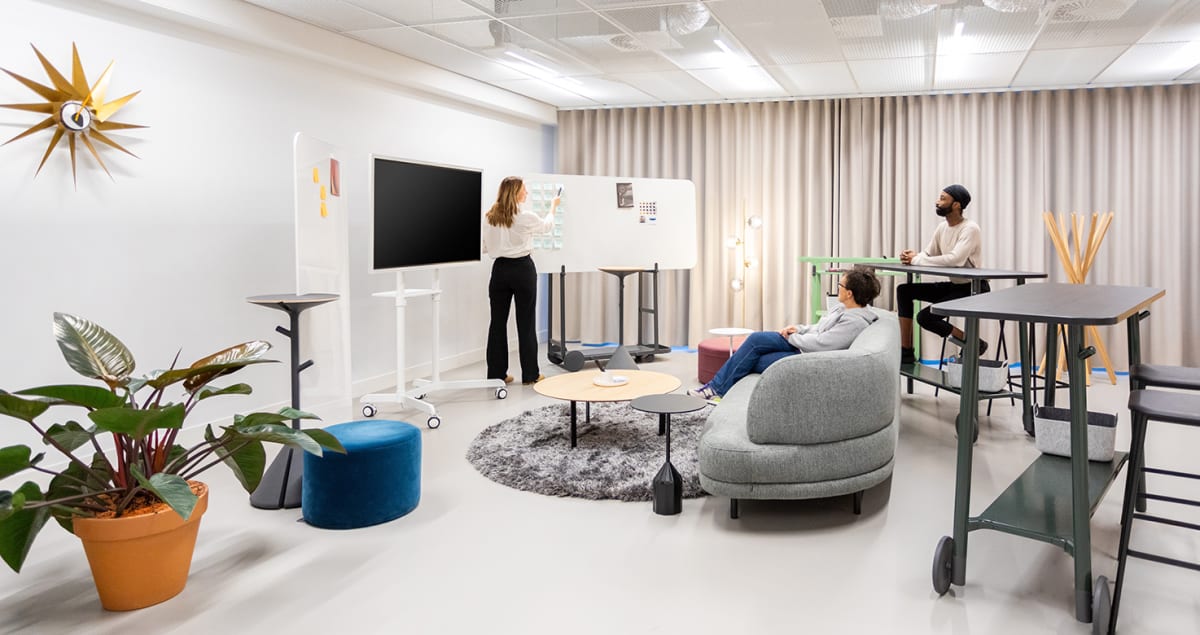Hybrid working trends will fuel the growth of local flexspaces and put an emphasis on the office experience – with a raft of benefits for people, profits and the planet.
As the hybrid work movement intensifies around the world, it’s no exaggeration to say that – for hundreds of millions of people – working life will never be the same again. For companies making the leap to hybrid, brokers can play an invaluable role in helping them to navigate the new world of work.
IWG’s white paper, The Future of Work reveals the ten trends brokers need to know for the new world of work, that will help to shape and inform their clients' workspace strategies.
Reduced overheads
One of the many benefits of hybrid working is that offices no longer have to accommodate all employees at the same time, meaning companies can downsize their real estate footprint, reducing their overheads from rent and other associated costs.
The potential savings are significant: according to Global Workplace Analytics, employers can save about US$11,000 every year for every person working in the hybrid model. Companies can boost their profit margins and reinvest the cash into other areas, such as learning and development for their employees, as well as growing the business.
Revitalising local areas
Now that the workforce is no longer tied to sprawling offices in city centres, a new trend of suburban revitalisation is emerging as workers spend more time (and money) close to where they live.
In the UK, IWG has seen the highest increase in demand for its flexible workspaces in suburban areas such as Bromsgrove and Andover. “With hundreds more rural and suburban flexible working locations expected to open, we expect a wide range of vibrant local communities to develop with thriving businesses at their heart,” says Mark Dixon, Founder and CEO of IWG.
Supporting employees
During the Covid-19 pandemic, employee wellbeing, both physical and mental, took centre stage. Moving forwards, wellbeing and avoidance of burnout will continue to be of prime importance, with human relations taking the place of human resources.
The hybrid model empowers employees to find a way of working that suits them best, giving them a better work-life balance that doesn’t involve a long commute to a city-centre office five days a week. This is paving the way for the trend of workforce dispersion, as employees can choose to relocate to rural or coastal areas where they can enjoy a better quality of life (and cheaper house prices).
Hybrid working will also enable businesses to recruit from a much wider talent pool, rather than limiting their search to certain areas within commutable distance to their headquarters. As a result, businesses will be seeking brokers’ advice on where to look for space in the new world of work, to meet the requirements of their newly distributed workforces.
Working better and more effectively
Cloud-based tech has been central to the success of hybrid working, and more online tools are likely to be rolled out to aid companies both large and small when it comes to virtual collaboration. A little further into the future, the metaverse will transform the world of videoconferencing, allowing us to interact as avatars in whatever virtual setting we choose.
Measuring productivity will also be the next logical step in the hybrid revolution, as businesses focus on effectiveness as an output rather than presenteeism. Tools that monitor, track and assess workflow such as Quixy, Hive and Nintex are likely to be integrated into an increasing number of company operations.
Of course, there are certain aspects of employee performance that can’t be measured, such as fresh thinking and innovation – and the physical workplace will remain a vital place for collective creativity. Employers will be expecting inspiring and interactive spaces that enhance creativity, relationship building and face-to-face communication, while enabling their employees to use these facilities in a way that best fits their own lifestyles and working needs.
The sustainability dividend
Companies across 2022 and beyond will be turning to brokers to advise them on how the hybrid model – and flexspace – can help them achieve their ESG goals. As Mark Dixon puts it: “There’s no doubt that sustainability is now very much front of mind for companies around the world – and they know this is something their customers expect.”
The hybrid working model brings considerable sustainability benefits. The most obvious, perhaps, is the significant reduction in their carbon footprint that can be achieved through a smaller real estate portfolio (including extensive savings on energy and water consumption) and the reduced need to commute. But hybrid working can also benefit many other areas, including gains in gender equality, good health and wellbeing, clean energy and sustainable communities.
Read more about the ten trends in IWG’s white paper, The Future of Work: a trends forecast for 2022.
An industry leader for more than 30 years, IWG is helping property brokers find the flexspace solutions their clients need in this new world of work.






